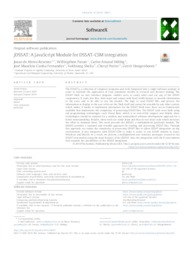jDSSAT: A JavaScript Module for DSSAT-CSM integration.
jDSSAT: A JavaScript Module for DSSAT-CSM integration.
Author(s): RESENES, J. de A.; PAVAN, W.; HÖLBIG, C. A.; FERNANDES, J. M. C.; SHELIA, V.; PORTER, C.; HOOGENBOOM, G.
Summary: The DSSAT is a collection of computer programs and tools integrated into a single software package inorder to facilitate the application of crop simulation models in research and decision making. The DSSAT Shell, an user interface program, enables users to easily select and use any of the DSSAT components. It reads text files, both input and output with fixed width format, to provide informationto the users and to be able to run the models. The logic to read DSSAT files and process theinformationtodisplaytotheuserreliesontheShellitselfandcannotbereusablebyanyothersystem,which makes it harder to implement alternatives for the DSSAT Shell since there are no frame works available that implements the complexity of processing DSSAT files. The DSSAT tools were built using old programming technologies such Visual Basic which is in end-of-life support and Delphi, these technologies should be replaced for a modern and standardized software development approach for abetter maintainability. Besides, these tools are standalone and they do not share code which increases the effort to maintain them. This work presents the jDSSAT, a multiplatform JavaScript module. Thej DSSAT provides a standard and reusable approach for reading and processing DSSAT files. Throughthis approach, we isolate the complexity of processing DSSAT files to allow DSSAT integration on anyenvironment. It also integrates with DSSAT-CSM to make it easier to run DSSAT models in Linux,Windows and MacOS. As a result, we present a multiplatform user interface prototype created to run DSSAT crop models using the main feature sof the jDSSAT. Also,the integration with the Renvironment that expands the possibilities of the DSSAT integration.
Publication year: 2019
Types of publication: Journal article
Unit: Embrapa Wheat
Keywords: Crop simulation, DSSAT, JavaScript
Observation
Some of Embrapa's publications are published as ePub files. To read them, use or download one of the following free software options to your computer or mobile device. Android: Google Play Books; IOS: iBooks; Windows and Linux: Calibre.
Access other publications
Access the Agricultural Research Database (BDPA) to consult Embrapa's full library collection and records.
Visit Embrapa Bookstore to purchase books and other publications sold by Embrapa.

